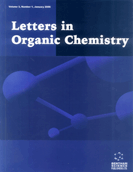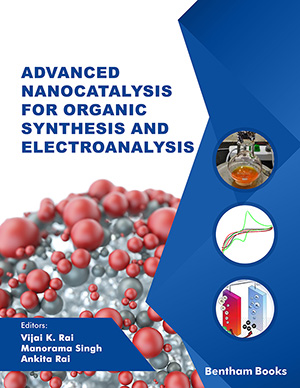
Abstract
Aim: The objective of the work is to synthesize, characterize and biochemically analyze Azo-metal complex of Embelin with Second Group Transition Metals.
Background: The genus Embelia is a well-known herb and has considerable importance in the field of pharmaceutical chemistry. The plant species has been used considerably as a traditional medicine in Ayurveda, old Chinese medicine, and Siddha for a long time. The dried berries of this plant, called “vidanga” have boundless biochemical properties, like anthelmintic, carminative, antibacterial, antibiotic, and hypoglycemic.
Objective: Embelin, metal-embelin (EM) and azo-metal-embelin (EAM) complexes were synthesized, analysed for antioxidant and antimicrobial properties.
Methods: The metal-embelin (EM) complexes and metal-azo-embelin (EAM) complexes were synthesized by pure mixing of embelin, azo-embelin and metals viz, Tc, Ru, Rh, Pd, Ag and Cd. The embelin and EAN complexes were analysed by various spectroscopic techniques, viz, UV-visible, FTIR, NMR, TGA, MS and CHNS analysis.
Results: The results authenticate the reaction between metals, and bidentate embelin occurs via quinonic and enolic oxygen atoms as [M (Emb) 2 (H2O)] 2H2O and [M (Emb-Azo)2 (H2O)2]. The antioxidant results show that the complexation between metals and compounds decreases the antioxidant potential significantly. In contrast, the antimicrobial activity shows that cobalt and nickel embelin complexes showed more than 74% growth inhibition against the concerned microbes in comparison to embelin alone.
Conclusion: As the results are taken into consideration, the scavenging property of embelin shows the reduction in power upon complexation with metals and azo-metals. Also, embelin and its associates as metal-embelin and metal-azo-embelin can be used as antioxidant and antimicrobial agents significantly.
Keywords: Embelin, metal-azo-embelin complex, biochemical, spectroscopic analysis, transition metals.
[http://dx.doi.org/10.1016/j.biopha.2016.12.001] [PMID: 27984799]
[http://dx.doi.org/10.1080/14786419.2016.1166499] [PMID: 27104858]
[http://dx.doi.org/10.1080/10286020.2020.1776266] [PMID: 34253100]
[PMID: 15700782]
[http://dx.doi.org/10.1002/jccs.200500029]
[http://dx.doi.org/10.1021/np060284m] [PMID: 17125236]
[http://dx.doi.org/10.1002/ptr.5175] [PMID: 24849650]
[http://dx.doi.org/10.1080/14786419.2018.1479703] [PMID: 29798678]
[http://dx.doi.org/10.1080/14786419.2019.1687475] [PMID: 31698951]
[http://dx.doi.org/10.1080/00387010.2019.1682013]
[http://dx.doi.org/10.1517/13543784.2014.867016] [PMID: 24397264]
[http://dx.doi.org/10.1016/j.ijpharm.2019.118637] [PMID: 31550511]
[http://dx.doi.org/10.2174/1389557519666191015202723] [PMID: 31644404]
[http://dx.doi.org/10.1186/s43094-019-0011-z]
[http://dx.doi.org/10.1016/S0040-4020(01)98407-8]
[http://dx.doi.org/10.1155/MBD.2000.121] [PMID: 18475934]
[http://dx.doi.org/10.1016/S0308-8146(03)00278-4]
[http://dx.doi.org/10.1016/j.jfca.2006.01.003]
[http://dx.doi.org/10.1007/BF02028510] [PMID: 24227114]
[http://dx.doi.org/10.1016/S0367-326X(03)00066-2] [PMID: 12781816]
[http://dx.doi.org/10.1128/AAC.43.6.1459] [PMID: 10348770]
[http://dx.doi.org/10.1016/S1045-1870(96)80007-0]
[http://dx.doi.org/10.1016/j.ejmech.2010.01.072]
[http://dx.doi.org/10.1093/carcin/20.5.911] [PMID: 10334211]
[PMID: 8140244]
 24
24 1
1

























